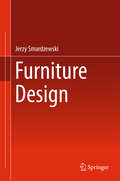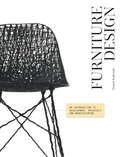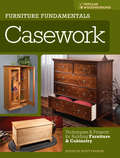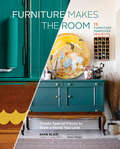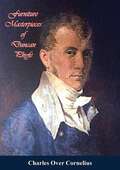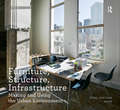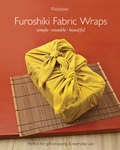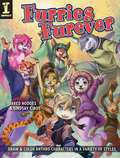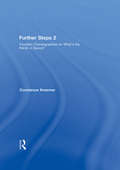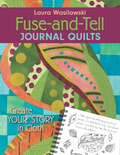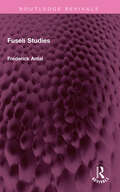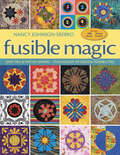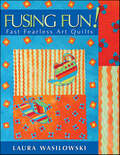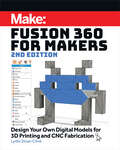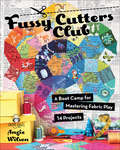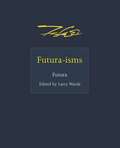- Table View
- List View
Furnishing Fascism: Modernist Design and Politics in Italy
by Ignacio G. GalánThe role of modernist interior design in the construction of Italian nationalism Along with the rise of Mussolini&’s fascist regime, the interwar years in Italy also saw the widespread development of its modernist interior design and furnishing practices. While the regime&’s politics were overtly manifest in monumental government architecture, Furnishing Fascism examines the subtler yet effective role of household goods and decor in the cultivation of Italy&’s exclusionary sense of national identity. Presenting a fresh look at the work of various architects and designers, including iconic figures such as Gio Ponti and Carlo Enrico Rava, Ignacio G. Galán explores how seemingly neutral products of everyday life contributed to the propagation of fascist ideology. Through extensive promotion in popular magazines and department stores, on the film sets of Cinecittà Studios, and throughout the country&’s colonial territories, Italy&’s modernist design practices were part of a larger political project that aimed to produce a totalizing image of cultural hegemony. Interweaving design theory, architectural history, and media scholarship, Furnishing Fascism reexamines the period&’s so-called minor arts to reveal the political entanglement of modernism in early twentieth-century Italy and offers valuable insight into the complications of cultural production under the auspices of authoritarian power. Retail e-book files for this title are screen-reader friendly with images accompanied by short alt text and/or extended descriptions.
Furniture Design
by Jerzy SmardzewskiMaximizing reader insights into the principles of designing furniture as wooden structures, this book discusses issues related to the history of furniture structures, their classification and characteristics, ergonomic approaches to anthropometric requirements and safety of use. It presents key methods and highlights common errors in designing the characteristics of the materials, components, joints and structures, as well as looking at the challenges regarding developing associated design documentation. Including analysis of how designers may go about calculating the stiffness and endurance of parts, joints and whole structures, the book analyzes questions regarding the loss of furniture stability and the resulting threats to health of the user, putting forward a concept of furniture design as an engineering processes. Creating an attractive, functional, ergonomic and safe piece of furniture is not only the fruit of the work of individual architects and artists, but requires an effort of many people working in interdisciplinary teams, this book is designed to add important knowledge to the literature for engineer approaches in furniture design.
Furniture Design
by Jim PostellThe comprehensive guide to furniture design— expanded and updated Furniture designers draw on a range of knowledge and disciplines to create their work. From history to theory to technology, Furniture Design offers a comprehensive survey of the essential craft- and practice-related aspects of furniture design. Generously illustrated with photographs and drawings—including a new color section—this Second Edition features updated coverage of material specifications, green design, digital design, and fabrication technologies. It also features twenty-five case studies of furniture design that represent a broad selection of works, designers, and techniques, including recent designs produced within the last decade. The book explores: Furniture function and social use Form, spatial organization, and typological orders Structural integrity and composition Accessibility, universal design, human factors, and ergonomics The design process, from schematics through fabrication Materials, processes, and methods of fabrication Professional practice and marketing The history of furniture design, from prehistory to the digital age Complete with a glossary of terms and a comprehensive bibliography, Furniture Design, Second Edition is a one-stop resource that furniture designers will turn to regularly for the advice, guidance, and information needed to perform their craft.
Furniture Design, second edition: An Introduction to Development, Materials and Manufacturing
by Stuart LawsonA unique and comprehensive resource for student and professional furniture designers, providing in-depth answers to their questions about aesthetics, function, materials, manufacturing and sustainability. In this second edition Stuart Lawson emphasizes the principles of a circular economy and what this means for furnituredesign and consumption. He considers the latest technological developments such as 3-D printing and the use of innovative materials such as bioplastics. He also examines the capabilities and potential of CAD-based design optimization, AI and machine learning-driven generative design processes.The book features case studies on pioneering, contemporary and historical designers and includes an illustrated directory of materials and manufacturing processes.
Furniture Design, second edition: An Introduction to Development, Materials and Manufacturing
by Stuart LawsonA unique and comprehensive resource for student and professional furniture designers, providing in-depth answers to their questions about aesthetics, function, materials, manufacturing and sustainability. In this second edition Stuart Lawson emphasizes the principles of a circular economy and what this means for furnituredesign and consumption. He considers the latest technological developments such as 3-D printing and the use of innovative materials such as bioplastics. He also examines the capabilities and potential of CAD-based design optimization, AI and machine learning-driven generative design processes.The book features case studies on pioneering, contemporary and historical designers and includes an illustrated directory of materials and manufacturing processes.
Furniture Design: An Introduction To Development, Materials And Manufacturing
by Stuart LawsonFurniture Design is a comprehensive guide and resource for students and furniture designers. As well as discussing pioneering contemporary and historical designs, it also provides substantive answers to designers’ questions about function, materials, manufacture and sustainability, integrating guidance on all of these subjects – particularly material and manufacturing properties, in one accessible and structured volume. Many leading contemporary furniture designers from around the world are included, with case studies carefully selected to highlight the importance of both material and manufacture-led design processes. The book is also intended to provide an insight into furniture design for those considering a university education in product and industrial design.
Furniture Design: An Introduction to Development, Materials, Manufacturing
by Stuart LawsonFurniture Design is a comprehensive guide and resource for students and furniture designers. As well as discussing pioneering contemporary and historical designs, it also provides substantive answers to designers’ questions about function, materials, manufacture and sustainability, integrating guidance on all of these subjects – particularly material and manufacturing properties, in one accessible and structured volume. Many leading contemporary furniture designers from around the world are included, with case studies carefully selected to highlight the importance of both material and manufacture-led design processes. The book is also intended to provide an insight into furniture design for those considering a university education in product and industrial design.
Furniture Fundamentals - Casework: Techniques and Projects for Building Furniture and Cabinetry
by Scott FrancisBuild your skills by building boxes! Mastering casework--essentially making boxes--allows you to create a wide variety of furniture from cabinets to bookcases to blanket chests. Within these pages, you'll find insight into various approaches to casework including face frames, frameless constructions and joinery options from simple to advanced. You'll learn the most used joinery techniques including rabbets, dados, dovetails and mortise-and-tenon. You'll gain insight into making boxes of all sizes from carcases to drawers, and hone your skills through 9 step-by-step furniture projects ranging from simple wall cabinets to beautiful chests of drawers. When you get right down to it, so many furniture forms start with building a box. This book is your guide to mastering this fundamental aspect of furniture making.
Furniture Makeovers: Simple Techniques for Transforming Furniture with Paint, Stains, Paper, Stencils, and More
by Barb BlairTransform tired furniture into stunning showpieces: “A fabulous how-to volume for everything from sanding to decoupage and beyond.” —The City Sage blogYou’ll never look at a hand-me-down dresser the same way again! This book offers twenty-six easy-to-follow techniques that can be applied to all different types of pieces, from bookshelves to desks: painting, applying gold leaf, wallpapering, distressing, dip dyeing, and more. In addition to the core techniques, author and Knack Studios founder Barb Blair shares thirty beautiful before-and-after makeovers from her studio and outlines how to achieve each look. With helpful step-by-step photographs, a visual glossary explaining all the tools and materials needed, and a lovely contemporary aesthetic, Furniture Makeovers is a treasure trove of ideas and instruction for the home decorator.“Her amply illustrated book shows why her repurposed furniture is in demand.” —Publishers Weekly
Furniture Makes the Room: Create Special Pieces to Style a Home You Love
by Barb BlairFifteen before-and-after furniture projects to create statement pieces—and tips on how to build a room around them: “As useful as it is beautiful.” —Justina Blakeney, New York Times–bestselling author of JungalowKnack Studio founder Barb Blair is famous for her knack with furniture—spotting classic pieces and transforming them into modern showstoppers. In this inspiring book, Blair goes beyond the nuts and bolts of furniture refinishing to show how to style rooms with each customized piece. For instance, she transforms a well-worn coffee table with a painted ombré design, and then reveals how to incorporate it into a bright and sunny den, a cozy reading nook, and a cheerful bedroom. With instructions for fifteen before-and-after furniture projects—dressers, tables, beds, armoire, and more—in Blair’s signature bold style, a “toolbox” section detailing her favorite techniques and materials, and photos of dozens of inspiring interiors, Furniture Makes the Room unlocks the secrets to decorating livable rooms around statement pieces.
Furniture Masterpieces of Duncan Phyfe [Illustrated Edition]
by Charles Over CorneliusThis well-known reference work has been consulted by generations of collectors, curators, dealers, historians, and craftsmen, and it remains in use decades after its initial publication. Photographs and measured drawings of the most striking furniture pieces of the sixteenth through nineteenth centuries constitute the major part of the book; the accompanying text indicates stylistic features and developments, prototypes, types of wood, function, and location of the original. Selected mainly from collections in the Metropolitan Museum of Art, Boston Museum of Fine Arts, and the Museum of the Rhode Island School of Design, the objects include chests, tables, chairs, dressing tables, desks, highboys, commodes, couches, and other furniture. Periods and styles include Colonial American, Duncan Phyfe, Windsor, Sheraton, Hepplewhite, Chippendale, Louis XIV, eighteenth-century Dutch, sixteenth-century Italian, and representatives of other eras. The book's most outstanding features are the measured drawings for each piece of furniture. Accurate to the nearest 1/16th of an inch, these drawings are especially valuable for woodworkers creating detailed replicas.-Print ed.
Furniture for Interior Design
by Drew PlunkettThis comprehensive, practical guide explores how contemporary furniture is used within interior design to define a space, create division and enclosure, and alter or redefine circulation. Initial chapters illustrate the different contexts in which furniture is used, from the office and domestic interiors to retail and exhibition space; look at types of furniture, whether off-the-shelf or bespoke; and explore the new vogue for recycling and vintage. Later chapters examine both traditional materials such as wood and the more unusual such as stone and glass, while also explaining new methods of manufacture – such as Computer Numerical Controlled and Selected Laser Sintering. The final chapter looks at how a design is developed, the site surveyed, prototypes made and specifications and schedules drawn up.Furniture for Interior Design is a detailed, highly illustrated guide to specifying and placing existing manufactured furniture, but also shows the reader how to design, detail, and commission batch-produced furniture or one-off, site-specific pieces.
Furniture for Interior Design
by Drew Plunkett Sam BoothThis comprehensive, practical guide explores how contemporary furniture is used within interior design to define a space, create division and enclosure, and alter or redefine circulation. Initial chapters illustrate the different contexts in which furniture is used, from the office and domestic interiors to retail and exhibition space; look at types of furniture, whether off-the-shelf or bespoke; and explore the new vogue for recycling and vintage. Later chapters examine both traditional materials such as wood and the more unusual such as stone and glass, while also explaining new methods of manufacture – such as Computer Numerical Controlled and Selected Laser Sintering. The final chapter looks at how a design is developed, the site surveyed, prototypes made and specifications and schedules drawn up.Furniture for Interior Design is a detailed, highly illustrated guide to specifying and placing existing manufactured furniture, but also shows the reader how to design, detail, and commission batch-produced furniture or one-off, site-specific pieces.
Furniture, Structure, Infrastructure: Making and Using the Urban Environment (Design Research in Architecture)
by Nigel BertramObservation and analysis are types of invention. They make things apparent which perhaps were invisible. By noticing, drawing and naming something we bring it into being. On the other hand, building and making can be thought of as analytical observations, pointing out what had not been so clear before and revealing the potential for other actions yet to occur. This book is a collection of urban research and architectural projects by award-winning architects Nigel Bertram / NMBW Architecture Studio, using observation as a design tool and design as an observational method. Through this process, a position on the making of architecture and on the role of architecture within the wider urban environment is established; embracing the full messy reality of the present, finding delight in the everyday and developing sensitivity to a range of found environments. By taking pre-existing conditions seriously, each project, architectural or analytical, large or small, becomes understood as the strategic renovation of a continuing state. This method of working operates by thinking simultaneously at different scales, from furniture to structure and infrastructure, searching for combinations of what might normally be separated into different categories, moving between the many small and ad-hoc actions of individuals to wider systems of collective organisation. Thinking about the effects of small moves on the larger urban field (and vice-versa), the role of unplanned or uncontrolled events in relation to the inward focus of design; thinking about the combinatory effect of what is newly made with what is already there, for example, enables architecture and the city to be understood in relative terms - in terms of relationships. Between people, groups of people, things, and parts of things, actions and groups of actions: urban architecture is the social arrangement of activity with the physical arrangement of large and small parts of its environment. But what people do also changes the place in which they do it. Considering different scales and types of relationships between individuals and groups, insiders and outsiders, expected and unexpected actions can be a way of crossing categories and establishing new relations. Breaking down components of a given situation or brief, before re-grouping, can be used to flatten and redistribute hierarchies embedded within. Similarly, finding ways of carefully observing things just as they are in the present, helps to see around the presuppositions of familiarity, without worrying about cause or effect. These aims, techniques and thoughts are presented through the discipline of the architectural project, where precise strategies must in the end be found to define an exact physical arrangement and materiality, usually at minimum cost. This collection of works researches the manner in which such precision can also generate openness and indeterminacy, allowing and provoking the engagement of others.
Furoshiki Fabric Wraps: Simple, Reusable, Beautiful
by PixeladiesLearn how to create beautiful fabric wraps for gifts and more with these projects inspired by an ancient Japanese art.Take your gift, your potluck dish, or even your daily essentials, and wrap it all up furoshiki-style. This ancient, elegant Japanese art of enfolding objects in fabric is demonstrated with step-by-step instructions and a beautiful gallery of photos. What a great reason to dive into your fabric stash! Creative ideas for applying surface design techniques to make your own unique wraps are also included.• Learn to make 18 different wraps for 5 primary shapes: bag, box, flat, bottle, and basket• Present your gifts to family and friends with style and originality
Furries Furever: Draw and Color Anthro Characters in a Variety of Styles
by Jared Hodges Lindsay CibosDraw Fascinating Furries! There's so much to explore in the world of furries, from flamboyant costumes to spectacular hair styles to unforgettable expressions and poses--it's all here! The authors of Draw Furries and Draw More Furries have taken drawing these fantastical creatures to a whole other level--covering all of the bases. Immerse yourself in multiple easy-to-draw lessons and discover different coloring techniques, learn how to create realistic fur and scales and develop the skills to go about creating your own personal fursona! The possibilities are limitless when making these amazing anthropomorphic characters, so join Lindsay and Jared as they take you to the next level of your furtastic journey! Jam-packed with 25 step-by-step demonstrations to help you create a wide array of furries, ranging from slinky scalies to a modern day sphinx Loaded with a variety of different styles and techniques from contributing artists as they take you on a journey through their artistic processes Learn how to create a furry from start to finish, delving deeper into designing a personal wardrobe, exploring the perfect background for your characters and so much more
Further Steps 2: Fourteen Choreographers on What's the R.A.G.E. in Modern Dance
by Constance KreemerFurther Steps 2 brings together New York’s foremost choreographers – among them MacArthur ‘Genius’ award winners Meredith Monk and Bill T. Jones – to discuss the past, present and future of dance in the US. In a series of exclusive and enlightening interviews, this diverse selection of artists discuss the changing roles of race, gender, politics, and the social environment on their work. Bringing her own experience of the New York dance scene to her study, Constance Kreemer traces the lives and works of the following choreographers: Lucinda Childs, Douglas Dunn, Molissa Fenley, Rennie Harris, Bill T. Jones, Kenneth King, Nancy Meehan, Meredith Monk, Rosalind Newman, Gus Solomons jr, Doug Varone, Dan Wagoner, Mel Wong and Jawole Zollar.
Fuse-and-Tell Journal Quilts: Create Your Story in Cloth
by Laura WasilowskiFrom Journal or Sketchbook to Whimsical Art Quilts • Turn your favorite life moments into charming little fused quilts • Get started with 6 complete projects, then make your own one-of-a-kind creations • Put them together fast with easy fusing techniques: no-sew appliqué, no-baste quilting, even no-sew binding! • Easy enough for kids to make on their own Do you keep a diary or sketchbook? Transform your musings, doodles, and snapshots into these small, fun-to-make journal quilts. They're so easy, it takes just a few hours to go from inspiration to finished quilt. Try Laura's new fusible techniques-bias fusing, cheesecloth, trapunto, even fusible binding. A fun new way to use fast2fuse® Double-Sided Fusible Stiff Interfacing!
Fuseli Studies (Routledge Revivals)
by Frederick AntalFirst published in 1956, Fuseli Studies deals with the many-sided artistic achievements of Zurich-born Fuseli’s baffling personality, who was one of the most erudite and renowned intellectuals of his day in Europe. The author’s intention has been to place his subject in clear historical perspective within his own epoch, and thus traces Fuseli’s contacts back to sixteenth-century mannerism and forward to twentieth-century expressionism. In this book, the social background of that absorbing period covering the artist’s working years at the turn of the nineteenth century is evoked not only in analysing his style, poised between classicism and romanticism of the age, but also accounting for its appeal and relevance to the present day. This book will be of interest to students of art, art history, European history, and literature.
Fusible Magic
by Nancy Johnson-SrerboMake Any of These Blocks in One Hour or Less • Make a quilt in just a day with your choice of 23 full-size pattern shapes, plus 5 bonus leaf and stem patterns • 9 fusible projects are quick and fun, with minimal sewing and no waste! • Inspiration gallery shows fusing ideas for wearables, home décor, and even scrapbooking • Basic instructions included for choosing fabrics and making templates for your designs • Learn Nancy's "no fail" secrets for fusing Create a variety of projects that reflect your individual style with easy fusible shapes. Make your own magic combinations with 28 different pattern shapes that work together beautifully in quilts, clothing, and more.
Fusing Fun!: Fast Fearless Art Quilts
by Laura WasilowskiNo-Sew (well, almost!) Art Quilts That YOU Can Create! YES YOU CAN create an art quilt this weekend! Engage your right brain with freewheeling collage techniques Give your sewing machine a rest: no sewing needed except for quilting and binding Design as you go - no measuring, no math! You can even fuse your way to finishing, binding, and displaying your art! PLUS find fun, no-quilt fabric collage projects Eye-popping gallery of quilts by Caryl Bryer Fallert, Jane A. Sassaman, David Walker, and MORE *Important Note about PRINT ON DEMAND Editions: This title will be printed after purchase and will arrive separately from any in-stock items. Please allow approximately 2 weeks for USA delivery, with an additional 2 weeks for international shipments. Expedited shipping is not available on POD Editions. The printing quality in this copy will vary from the original offset printing edition and may look more saturated due to printing on demand by a high-quality printer on uncoated (non-glossy) paper. The information presented in this version is the same as the most recent printed edition. Any pattern pullouts have been separated and presented as single pages.
Fusion 360 for Makers: Design Your Own Digital Models for 3D Printing and CNC Fabrication
by Lydia Sloan ClineLearn how to use Autodesk Fusion 360 to digitally model your own original projects for a 3D printer or a CNC device. Fusion 360 software lets you design, analyze, and print your ideas. Free to students and small businesses alike, it offers solid, surface, organic, direct, and parametric modeling capabilities.Fusion 360 for Makers is written for beginners to 3D modeling software by an experienced teacher. It will get you up and running quickly with the goal of creating models for 3D printing and CNC fabrication.Inside Fusion 360 for Makers, you'll find:Eight easy-to-understand tutorials that provide a solid foundation in Fusion 360 fundamentalsDIY projects that are explained with step-by-step instructions and color photosProjects that have been real-world tested, covering the most common problems and solutionsStand-alone projects, allowing you to skip to ones of interest without having to work through all the preceding projects firstDesign from scratch or edit downloaded designs. Fusion 360 is an appropriate tool for beginners and experienced makers.
Fusion 360 for Makers: Design Your Own Digital Models for 3D Printing and CNC Fabrication
by Lydia Sloan ClineLearn how to use Autodesk Fusion 360 to digitally model your own original projects for a 3D printer or a CNC device.
Fussy Cutters Club: A Boot Camp for Mastering Fabric Play—14 Projects
by Angie WilsonGet the most out of your print and novelty fabrics with this guide to the technique of fussy cutting—with 14 easy quilting projects!Angie Wilson is a master of cutting fabrics with intention, using prints and patterns to add humor, curiosity and unexpected detail to her quilts and textile crafts. With her tips and techniques, you will learn how to look at your stash with new eyes and piece together the best bits, like making a colorful collage of your favorite things. Use templates to zero in on motifs and create secondary patterns from your fabrics, fussy cutting for color as well as design. Try your hand at 14 fun projects from traditional and improv piecing to English paper piecing and more!
Futura-isms (ISMs)
by FuturaA collection of fascinating quotations from the legendary artist and graffiti pioneerFutura is a living legend—a world-renowned painter, designer, and photographer who was a pioneer of graffiti art and New York City’s “subway school.” His radical abstract work in the street and on canvas established him as a central figure in an important art movement that included Jean-Michel Basquiat, Keith Haring, Rammellzee, Lee Quiñones, and Dondi White. Futura-isms is a collection of essential quotations from this fascinating artist. Gathered from four decades of interviews and panel discussions, this memorable selection illuminates Futura’s thoughts on legal and illegal art, his influences, fellow artists, and the past, present, and future. He also offers colorful memories of his adventurous life—growing up in New York City, serving in the Navy, touring with The Clash—and reflects on how his experiences have shaped his art.Select quotations from the book:“Graffiti was a way for me to exist. I wanted the world to know my name. I wanted to be somebody.”“The essence of what graffiti is . . . is creating this identity and taking it to the public.”“My whole life, I think, I’ve been a nomad.”“I was always at home in the subway system.”“People say, ‘Let’s play within the rules.’ I say, ‘No—let’s break the rules a little bit.’”

